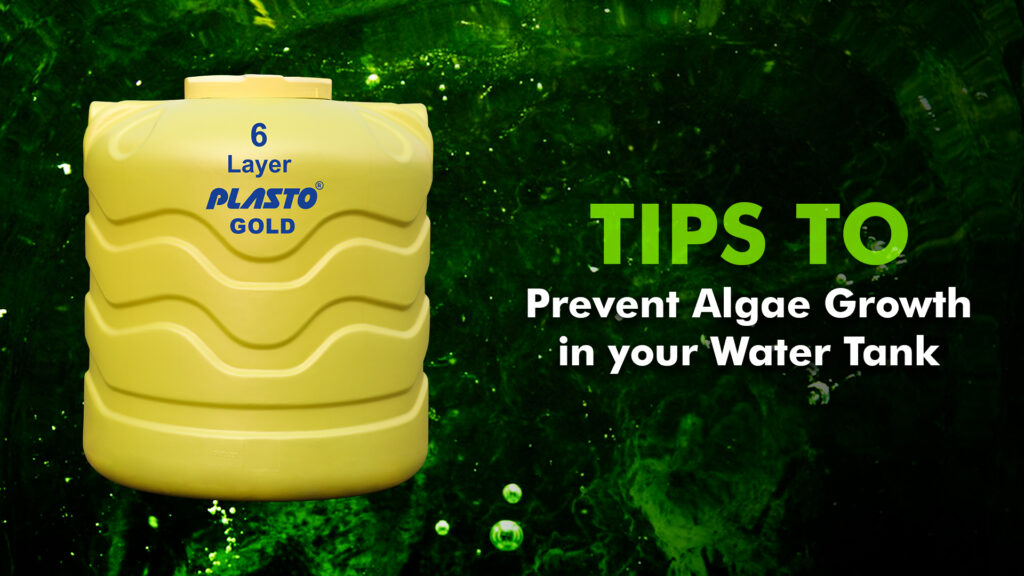
Preventing algae growth in water tanks is crucial for safeguarding the quality and safety of stored water, protecting public health, reducing maintenance costs, and ensuring a reliable supply of clean water for various purposes.
Algae can negatively affect water quality by imparting a bad taste and odor to the water. It can also cause water to become cloudy, making it visually unappealing. Some types of algae can produce toxins that are harmful to human health. Consuming water contaminated with these toxins can lead to a range of health issues, including gastrointestinal problems, skin irritation, and, in severe cases, more serious illnesses. Algae can clog water distribution systems, filters, and pipes as well. Algae growth can also result in reduced oxygen levels as algae consume oxygen during their growth and decay processes
How to Prevent the Growth of Algae:
Using UV protected tanks
The UV protection technology in Plasto water tanks primarily serves to prevent damage and degradation of the tank material caused by ultraviolet (UV) radiation from sunlight. It indirectly contributes to the prevention of algae by maintaining the integrity of the tank and reducing conditions conducive to algae growth.
Material Weakening: UV radiation can weaken the tank material, making it more prone to cracks, leaks, and structural failure over time. Damaged tanks may develop small openings that allow contaminants, including algae spores, to enter. Since Plasto tanks are UV protected, they are not prone to such damage.
Surface Cracking: UV exposure can cause surface cracking, which creates rough areas on the tank interior where algae can anchor and grow.
Color Fading: UV radiation can cause color fading or discoloration of the tank material, reducing the tank’s ability to block light and inhibit algae growth.
Plasto’s UV protection measures, such as UV stabilizers in tank materials or UV-resistant coatings, help preserve the structural integrity and appearance of the tank. A well-maintained and structurally sound tank is less likely to develop areas where algae can thrive.
Using tanks with threaded UV protected lid
The Plasto UV-protected threaded tank lid serves as a component of a larger system to help prevent algae growth in a water tank. It contributes to algae prevention in the following ways:
Light Blockage: The Plasto UV-protected tank lid is designed to block or reduce the penetration of ultraviolet (UV) light from the sun into the water tank. Algae require light for photosynthesis, so by minimizing the amount of UV light entering the tank, the lid helps create an environment less conducive to algae growth.
Preventing Algae Introduction: Plasto threaded tank lid acts as a barrier that seals the tank’s opening securely. This prevents outside contaminants, including algae spores, leaves, debris, and microorganisms, from entering the tank. Algae spores are present in the environment, and they can be introduced into the tank through various means, such as wind or rain. By sealing the tank with the Plasto threaded lid, you reduce the likelihood of introducing new algae into the tank.
Maintaining Water Quality: A sealed tank with the Plasto UV-protected threaded lid helps maintain the quality of the water within the tank. Water quality factors, such as temperature, nutrient levels, and oxygen content, play a role in preventing algae growth.
By preserving these conditions, the Plasto tank lid indirectly contributes to algae prevention.
Using an antimicrobial inner layer
The antimicrobial inner layer in Plasto water tanks is designed to inhibit the growth and proliferation of microorganisms, including algae, within the tank. Here’s how the Plasto antimicrobial inner layer works to prevent algae growth:
Microbial Inhibition: The Plasto antimicrobial inner layer is typically made of materials or coatings that contain agents designed to inhibit the growth of microorganisms. These agents can include antimicrobial additives, biocides, or silver ions, which have been shown to be effective at suppressing the growth of bacteria, fungi, and algae.
Preventing Algae Colonization: Algae growth typically begins when spores or cells from outside sources are introduced into the water. Once inside the tank, these algae cells can attach to surfaces and start to multiply. The antimicrobial properties of the inner layer of Plasto tanks work to prevent these algae cells from attaching and establishing colonies on the tank’s surface.
Reducing Biofilm Formation: Microorganisms, including algae, often form biofilms on surfaces within water tanks. Biofilms are slimy layers of microorganisms that provide protection and nutrients to the microorganisms, allowing them to grow and thrive. The antimicrobial inner layer disrupts biofilm formation, making it difficult for algae to anchor and grow.
Using a tank filter in tank outlet
The antimicrobial inner layer in Plasto water tanks is designed to inhibit the growth and proliferation of microorganisms, including algae, within the tank. Here’s how the Plasto antimicrobial inner layer works to prevent algae growth:
Microbial Inhibition: The Plasto antimicrobial inner layer is typically made of materials or coatings that contain agents designed to inhibit the growth of microorganisms. These agents can include antimicrobial additives, biocides, or silver ions, which have been shown to be effective at suppressing the growth of bacteria, fungi, and algae.
Preventing Algae Colonization: Algae growth typically begins when spores or cells from outside sources are introduced into the water. Once inside the tank, these algae cells can attach to surfaces and start to multiply. The antimicrobial properties of the inner layer of Plasto tanks work to prevent these algae cells from attaching and establishing colonies on the tank’s surface.
Reducing Biofilm Formation: Microorganisms, including algae, often form biofilms on surfaces within water tanks. Biofilms are slimy layers of microorganisms that provide protection and nutrients to the microorganisms, allowing them to grow and thrive. The antimicrobial inner layer disrupts biofilm formation, making it difficult for algae to anchor and grow.

